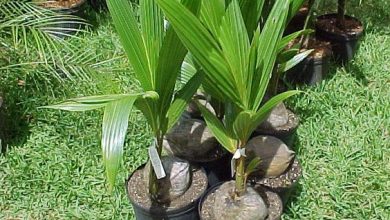Radish: [Crop, Irrigation, Associations, Pests and Diseases]
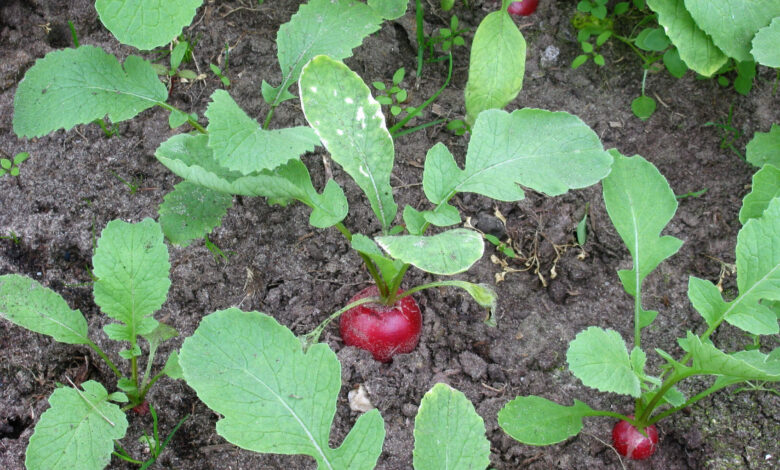
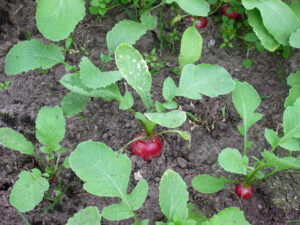 Where to sow? In full light. It needs a lot of sunlight.
Where to sow? In full light. It needs a lot of sunlight.- When? In spring and until late fall.
- How do we prepare the land? Removed, eliminating weeds . Clay and neutral soils with a substrate rich in nutrients.
- How do we water? With drip .
- How often do we water? Abundant to maintain the humidity of the crop, without excesses.
- Plagues and diseases? Aphids , larvae and caterpillars . Rot, radish breakage due to excess moisture.
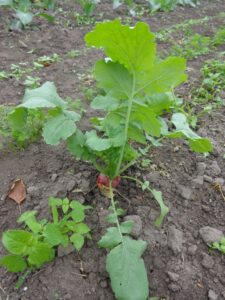 The radish, Raphanus sativu s , is a plant of the Cruciferous family, has its origin in China and is currently found throughout the world. Its fruit is a root that is purple on the outside and ice-white on the inside.
The radish, Raphanus sativu s , is a plant of the Cruciferous family, has its origin in China and is currently found throughout the world. Its fruit is a root that is purple on the outside and ice-white on the inside.
In Latin, radish is «radix» or root. The fruit has a spicy flavor that distinguishes it and makes it very special. Its seeds are dark brown circular with a diameter of 5mm.
Radish is highly valued in haute cuisine worldwide to accompany salads and cold dishes such as pickles. It is also used to make soups, stews and in some places for decoration.
The growing cycle for this plant is approximately 3-6 weeks, from sowing to harvest, depending on the variety. According to chemical studies, radish is a source of antioxidants and vitamin C, has anti-inflammatory properties, controls blood pressure, cleanses the kidneys and urinary tract.
When to plant radish?
Where to do it?
Sowing radish will be better in cool climates since temperatures below 12º C do not favor the development of the plant.
How to prepare the land?
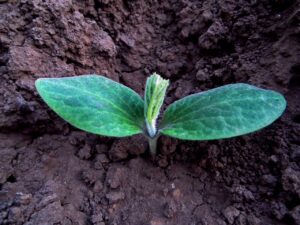 The preparation of the land for the cultivation of radish does not entail greater care since the plant adapts to all types of soils.
The preparation of the land for the cultivation of radish does not entail greater care since the plant adapts to all types of soils.
The perfect soil for radish growth should include deep, clay-type, neutral soils with a pH between 5.5 and 6.8.
The radish is a plant whose fruit are radishes that grow as roots and if the soil does not provide them with the required nutrients and with good humidity then it cannot develop.
The land for the cultivation of radish can be prepared by means of furrows that have a distance of 15 centimeters between them. The best soils are those that contain decomposing organic matter.
Around 20 million bacteria and one million fungi usually grow in a handful of soil. Radish requires a soil that is free of weeds and weeds so that the plant can develop and absorb all the nutrients it requires.
How do we water the radish?
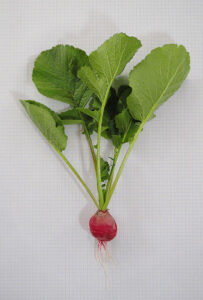 Radish requires specific care in terms of watering that has to do with maintaining uniform humidity, watering less frequently, but thoroughly, always watering at dusk or first thing in the morning.
Radish requires specific care in terms of watering that has to do with maintaining uniform humidity, watering less frequently, but thoroughly, always watering at dusk or first thing in the morning.
Always keep the leaves dry and add the correct amount of water. The plant requires that the soil always remain moist, but taking care not to cause puddles,
Radish is more sensitive to lack of water than other root plant species and during the near maturity period, overwatering should be avoided, as this could induce the plant to develop lateral roots.
In addition, if the irrigation is in excess the radish can present diseases, such as rotting or that the radish breaks. On the contrary, if the waterings are scarce but its permanent humidity, its flavor will be more spicy.
How do we plant a radish step by step?
Radish can be grown directly from seeds in a garden and does not require transplantation, so in the place where it is sown there it will develop and grow both in the ground and in containers.
Sowing in orchard
If the cultivation is done in an orchard, it is recommended:
- Deposit the seeds in furrows 1 to 2 centimeters deep, about 5 centimeters apart from each other.
- Keep a distance between the rows of approximately 5 centimeters in case of sowing in more than one row. It is very important to respect these spaces so that the radish has a good root development
- Water immediately after sowing, do not let the soil lose moisture.
Sowing in pots
In the case of a culture in containers or pots, the following steps should be followed:
- Select pots or containers with a depth of at least 15 centimeters and a minimum volume of one liter.
- Use a substrate rich in nutrients and that has good drainage.
- Sow the seeds in small rows 1-1.5 cm deep and with a distance of 8-12 cm between them, depending on the size of the variety.
- Place the seeds with a separation of 5 centimeters and cover with soil and mixture. If planted close together, the radishes will be affected by high temperatures and their roots will not grow properly, also altering their flavor.
- Fertilize the radish 15 days after sowing to provide more nutrients and encourage its growth.
The radish seedlings will emerge approximately 3 days after sowing, and the first leaves, cotyledons, will be heart-shaped.
Sometimes it is necessary to cover the radishes with a little soil after they have grown a little, so that they develop better. Always keep the land free of weeds.
What favorable associations does it have?
 The association of compatible plant crops produces benefits compared to their separate cultivation, in addition to the use of light, water and / or nutrients.
The association of compatible plant crops produces benefits compared to their separate cultivation, in addition to the use of light, water and / or nutrients.
There are no known favorable associations of radish cultivation with other species, however, this selection will correspond to horticulturists and specialists in the area in order to obtain better results.
What pests and diseases attack radish?
 Radish can have diseases caused by overwatering that can lead to rot and breakage of the radish.
Radish can have diseases caused by overwatering that can lead to rot and breakage of the radish.
Also pests and especially aphids and larvae affect the crop. A strong infestation of caterpillars can kill radish leaves in a couple of days.
In general, it is very important to check the radish crop, once or twice a week, especially the back of the leaves to detect any pests that may be present. To combat them, it is recommended to apply water with biodegradable soap or remove the caterpillars by hand.

![Photo of Nandina cuttings: [Grafts, Time, Rooting and Planting]](https://www.complete-gardening.com/wp-content/uploads/2022/08/nandina-cuttings-grafts-time-rooting-and-planting-390x220.jpg)
![Photo of The Guide to Learn How to Plant Lettuce Successfully [12 Steps]](https://www.complete-gardening.com/wp-content/uploads/2022/08/the-guide-to-learn-how-to-plant-lettuce-successfully-12-steps-390x220.jpg)
